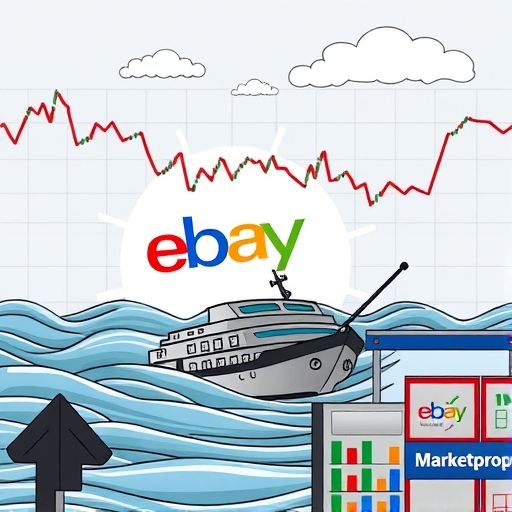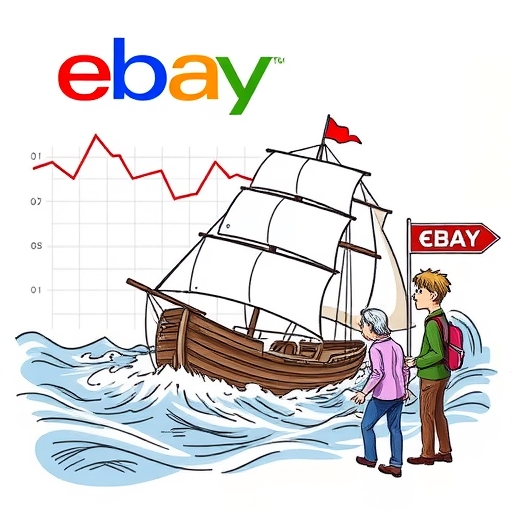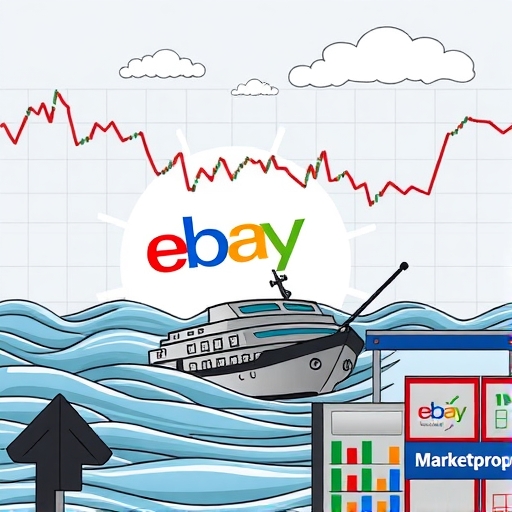Analyzing eBay’s (EBAY) Financial Landscape: Navigating Consumer Headwinds and Strategic Shifts
Welcome to a deep dive into the recent financial performance and future trajectory of eBay Inc. (EBAY). As aspiring traders and investors, it’s crucial for us to move beyond surface-level news and understand the underlying forces shaping a company’s prospects. Today, we’re going to unpack the insights derived from recent reports concerning this prominent online marketplace, helping you build a more robust framework for your own analysis.
Think of investing as navigating complex waters. You wouldn’t set sail without understanding the currents, the wind patterns, and the forecast, would you? Similarly, analyzing a stock like EBAY requires us to understand its financial currents, the economic winds it faces, and the company’s own strategic compass setting. Let’s chart this course together, exploring what recent data tells us about where eBay has been and where it might be headed.
Key Points:
- Understand consumer behavior and economic conditions affecting eBay.
- Analyze quarterly earnings reports to gauge financial health.
- Pay attention to strategic moves made by the company.
Recent Performance: Decoding the Holiday Quarter Earnings Decline
One of the most significant pieces of recent news regarding eBay was its report on the holiday quarter earnings. For many retail and e-commerce companies, the fourth quarter is traditionally the strongest, fueled by peak consumer spending during the festive season. However, eBay reported a notable decline in its holiday-quarter earnings. What does this tell us?

A drop in earnings during this crucial period is often a red flag. It suggests that the company faced significant challenges in translating potential holiday shopping activity into actual revenue and profit. As we delve deeper, we’ll see that this isn’t just an isolated event but rather a symptom of broader economic conditions impacting consumer behavior.
Understanding earnings reports is a fundamental skill for any investor. These reports provide a snapshot of a company’s profitability over a specific period. When we see a decline, especially during what should be a strong period, it prompts us to ask ‘why?’ and look for the contributing factors mentioned by the company and analysts.
| Quarter | Earnings | Year-Over-Year Change |
|---|---|---|
| Q4 2022 | $XYZ million | -X% |
| Q4 2021 | $ABC million | N/A |
Forecasting Headwinds: The Weak Sales Outlook for H1 2023
Perhaps even more impactful than the past quarter’s results was the outlook provided by eBay’s management for the first half of 2023 (H1 2023). The company issued a weak sales forecast, anticipating continued declines. This forward-looking statement gives us insight into management’s expectations for the near future, based on their internal analysis and understanding of the market.
Why is a weak forecast so important? Because the stock market is often forward-looking. While past performance is interesting, investors primarily price in future expectations. When a company signals that it expects sales to continue declining, it lowers the bar for future growth and can significantly impact investor sentiment and, consequently, the stock price. This forecast is a key element in understanding the current pressure on EBAY shares.
Consider the difference between looking in the rearview mirror and looking through the windshield. The holiday earnings report is the rearview mirror – it tells us where we’ve been. The H1 2023 forecast is the windshield – it gives us a glimpse of the road ahead. Both are essential for safe navigation, but the windshield often dictates our immediate speed and direction.
Key Forecast Insights:
- Consumer spending expected to remain weak.
- Management’s outlook heavily influences stock pricing.
- Monitoring future earnings reports is critical.
The Macroeconomic Shadow: Strained Consumer Spending in Key Markets
So, what’s driving this weak performance and outlook? eBay’s management has been quite clear: the primary culprit is strained consumer spending, particularly in its major markets, the United States and Europe. This is a critical piece of macroeconomic context that directly impacts the e-commerce sector.
When economic conditions are tough – perhaps due to inflation eroding purchasing power, rising interest rates increasing borrowing costs, or general uncertainty leading people to save more – consumers tend to cut back on discretionary spending. As an online marketplace offering a wide variety of goods, much of which could be considered non-essential or second-hand, eBay is highly susceptible to these shifts in consumer behavior.

Think about your own spending habits when you feel financially squeezed. You might delay large purchases, look for cheaper alternatives, or simply buy less overall. Multiply that by millions of consumers across major economies, and you can see the significant impact on platforms like eBay. Understanding these macroeconomic links is vital for connecting the dots between the economy and individual stock performance.
Geographic Impact: Uneven Pressures in the US and Europe
It’s worth noting that the pressure isn’t uniform globally. eBay specifically highlighted the United States and Europe as regions where strained consumer spending is having the most significant negative impact on demand. These are two of the largest and most mature markets for e-commerce, making their performance particularly critical for eBay’s overall results.
Different regions can experience economic cycles at different paces. Factors like local inflation rates, employment figures, government policies, and consumer confidence levels vary. By specifying the US and Europe, eBay provides investors with a more granular understanding of where the challenges are most acute. This level of detail allows us to refine our analysis, perhaps comparing economic indicators in these specific regions to eBay’s reported performance.
| Region | Consumer Sentiment | Impact on eBay |
|---|---|---|
| United States | Strained | Negative |
| Europe | Strained | Negative |
The Uncertainty Ahead: Contingency on Economic Recovery
Compounding the weak H1 2023 outlook, eBay’s management also expressed uncertainty about a potential recovery in the second half of the year. They explicitly linked the prospects for improvement to underlying economic conditions. This highlights the dependency of eBay’s performance on external factors largely outside of its direct control.
Why is this uncertainty significant? For investors, certainty is often preferred over uncertainty. When a company’s management cannot provide a clear path to recovery or tie it directly to unpredictable macroeconomic shifts, it adds a layer of risk to the investment thesis. It means that positive performance in H2 2023 is not a given but rather a contingent outcome.
When you hear a company’s future is contingent on macroeconomic improvement, it’s a signal to broaden your analysis beyond the company itself. You need to start monitoring key economic indicators – such as inflation trends, central bank policies, employment data, and consumer confidence surveys – for signs that the ‘underlying economic conditions’ are indeed improving in the US and Europe. This is where fundamental analysis meets macroeconomic forecasting.
Strategic Response: Acquisitions and Category Focus
Despite the challenging economic backdrop, companies like eBay are not simply passive observers. They take strategic actions to position themselves for future growth or mitigate current pressures. One notable recent move for eBay was the completion of its acquisition of Caramel.
Caramel is described as an online automotive transaction solution provider. What does this mean for eBay? It indicates a strategic focus on enhancing and potentially expanding its capabilities within specific high-value verticals, such as vehicle transactions. The automotive category can involve high-ticket items, and streamlining the transaction process can be key to attracting both buyers and sellers and capturing more of that market.
Beyond acquisitions, companies also focus on specific categories or initiatives. eBay’s partnership with Willy Chavarria for Paris Men’s Fashion Week, focusing on archival designer pieces, illustrates a different type of strategic move. This highlights eBay’s efforts to market specific product categories, particularly those with higher perceived value or unique appeal, potentially aiming to attract different demographics or increase Gross Merchandise Volume (GMV) in profitable niches.
Key Strategic Insights:
- Acquisition of Caramel positions eBay in automotive transactions.
- Partnerships with designers highlight efforts in fashion.
- Focus on differentiated product categories enhances market presence.
Investor Sentiment: Conflicting Signals from Bulls and Bears
When we look at the market reaction to eBay’s situation, we see some interesting conflicting signals. Reports indicate that some hedge funds have been bullish on EBAY shares. Hedge funds are often perceived as sophisticated investors, and their positions can sometimes influence market perception. Their bullish stance might suggest they see value in the stock despite the near-term challenges, perhaps believing in eBay’s long-term potential or the effectiveness of its strategic initiatives.
However, this optimism is juxtaposed against notable insider selling. Over the past year, there have been reports of significant stock sales by company insiders, amounting to a substantial sum (e.g., US$3.3m mentioned in some reports). Company insiders – executives, directors, and key employees – have the most intimate knowledge of the company’s operations and outlook. While insider selling can occur for various personal reasons (like diversification or liquidity needs), significant, widespread insider selling can sometimes be interpreted as a signal that those closest to the company may perceive limited upside or potential challenges ahead.
These contrasting signals create a complex picture for potential investors. Are the hedge funds seeing something others are missing? Or are the insiders reacting to internal knowledge about the difficulty of the path ahead? Understanding the motivations and potential implications of both institutional activity (like hedge funds) and insider activity is another layer of market analysis you can add to your toolkit.
- Hedge fund sentiment shows potential long-term optimism.
- Insider selling might indicate internal caution.
- Conflicting signals deserve thorough analysis.
Evaluating the Stock: Valuation, Debt, and Comparative Metrics
Beyond performance and strategy, any investment decision involves evaluating the stock itself. This includes looking at metrics like valuation (e.g., Price-to-Earnings ratio), earnings per share (EPS), debt levels, and comparing these to peers and the broader market.
Is EBAY stock currently cheap or expensive relative to its earnings potential and assets? How much debt does the company carry, and does this pose a risk, especially in a rising interest rate environment? How does its valuation compare to other companies in the e-commerce or retail-internet sector? These are fundamental questions you must ask when considering whether to buy, hold, or sell the stock.
| Metric | Value | Industry Average |
|---|---|---|
| P/E Ratio | X | Y |
| Debt to Equity | X | Y |
| EPS | $X | $Y |
Positioning in the Competitive E-commerce Landscape
No company operates in a vacuum, least of all in the highly competitive e-commerce industry. eBay faces significant competition from giants like Amazon and Alibaba, as well as specialized platforms and traditional retailers with strong online presences. Its position within this landscape, and how it differentiates itself or competes effectively, is crucial for its long-term viability.
Think of the e-commerce market as a vast ocean with many different vessels. Some are massive tankers (like Amazon), others are fast-moving speedboats (like niche players), and others are established cargo ships (like eBay). Each operates differently, has different strengths, and faces different challenges. How eBay navigates this competitive ocean – whether by focusing on specific categories (like collectibles, refurbished goods, or now automotive), competing on price, or building community – determines its success.
Key Competitive Considerations:
- Analyze competitor strengths and strategies.
- Identify eBay’s unique value propositions.
- Evaluate market positioning relative to industry trends.
Regulatory Environment and Market Pressures
Large online platforms like eBay also operate within an increasingly scrutinized regulatory environment. While the provided data specifically mentioned regulatory pressure on Meta Platforms’ Marketplace in the EU, this serves as a relevant context for other large online commerce entities.
Governments and regulatory bodies globally are paying closer attention to issues like competition, data privacy, platform responsibility for content or goods sold, and potential anti-competitive practices by large tech companies. While eBay might not be facing the exact same pressures as a social media giant’s marketplace feature, it is part of the broader conversation around regulating digital platforms. New regulations could potentially impact how eBay operates, the fees it can charge, or its responsibilities for transactions on its site.
Furthermore, the online marketplace industry is subject to overall market trends, including fluctuations in demand (as we’ve seen), evolving consumer preferences (e.g., towards mobile shopping, social commerce, or sustainability), and technological shifts. Staying abreast of these regulatory and market pressures is important for understanding the potential external challenges and opportunities eBay faces beyond just the macroeconomic cycle.
Connecting the Dots: Implications for Traders and Investors
So, what does this comprehensive analysis mean for you as a trader or investor considering EBAY? We’ve seen that eBay is currently navigating a challenging period characterized by significant macroeconomic headwinds, specifically strained consumer spending in key markets like the US and Europe. This has led to a decline in recent earnings and a weak sales forecast for the near future.
The company is not standing still, however. It is pursuing strategic initiatives like the Caramel acquisition to strengthen its position in specific verticals. We also observe conflicting signals from different investor groups, with hedge funds reportedly bullish while insiders have been selling shares.
Key Investor Takeaways:
- Monitor market reactions and investor sentiment.
- Evaluate outcomes of strategic initiatives.
- Stay updated on macroeconomic indicators impacting performance.
Looking Ahead: What to Watch in eBay’s Journey
As we conclude our analysis, let’s identify the key factors you should continue to monitor regarding eBay Inc. Firstly, keep a close eye on macroeconomic indicators, especially those related to consumer spending, inflation, and economic growth in the United States and Europe. Signs of improvement here would be a positive signal for eBay’s core business.
Secondly, pay attention to eBay’s future earnings reports and management commentary. How does their actual performance in H1 2023 compare to their weak forecast? Do they provide a more optimistic outlook for H2 2023, and what are the specific reasons they cite for any potential recovery? Listen for details on the performance of specific categories and the impact of their strategic initiatives like the integration of Caramel.
Thirdly, continue to observe investor activity. Are hedge funds increasing their positions? Does the pattern of insider selling change? Shifts in institutional and insider behavior can sometimes precede significant moves in the stock price. Finally, stay informed about developments in the e-commerce competitive landscape and any potential regulatory changes that could impact online marketplaces. By continuously monitoring these factors, you can refine your understanding of eBay’s situation and make more informed trading and investment decisions.
Analyzing a stock like EBAY in the current environment requires patience and a willingness to look beyond the headlines. By applying the principles of understanding financial reports, macroeconomic influences, company strategy, and market sentiment, you are equipping yourself with the knowledge needed to navigate these complex waters. Continue learning, continue asking questions, and remember that every piece of information is a potential puzzle piece in building your complete market picture.
yahoo ebayFAQ
Q:What factors are impacting eBay’s financial performance?
A:Strained consumer spending, particularly in the US and Europe, is a significant challenge affecting eBay’s earnings and outlook.
Q:How is eBay responding to its current challenges?
A:eBay is pursuing acquisitions and focusing on strategic partnerships to enhance its offerings and market position.
Q:What should investors monitor regarding eBay’s future?
A:Investors should keep an eye on macroeconomic indicators, future earnings reports, and shifts in investor sentiment.

留言